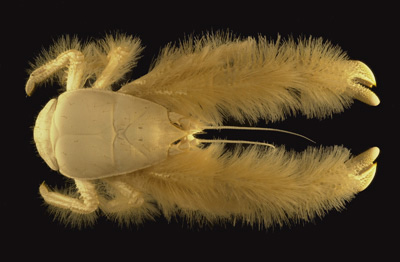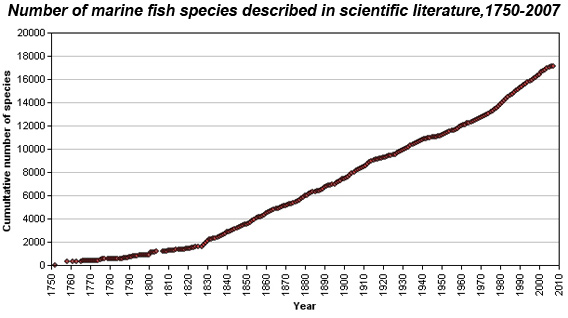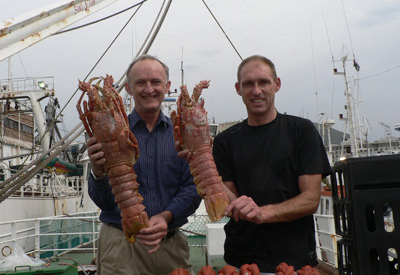Census of marine life opens with 122,000 species
Census of marine life opens with 122,000 species
Jeremy Hance, mongabay.com
July 1, 2008
|
|
Discovering a new species can be the highlight of a biologist’s career. Yet once a species enters the formal literature, complications may develop. The system has been especially problematic because for centuries biologists have lacked the tools to construct a full and flexible list of the world’s innumerable species. Using the Internet and hundreds of scientists around the world, the Census of Marine Life is attempting to take on this monumental task.
With 120,000 species now on-line, the Census of Marine Life considers itself half-way to its goal of checking and validating the 230,000 marine species currently known to science. Once completed, the World Register of Marine Species, called WoRMS, will be the first source for descriptions on all marine life.

Yeti Crab: This new species of crab was discovered off the Pacific-Antarctic Ridge in the South Pacific Ocean (37°46.50’S, 110°54.70’W). It was named Kiwa hirsuta kiwa, after the goddess of shellfish in Polynesian mythology, but has become known as the “yeti crab” because of its hairy appearance. The crab was collected by slurp gun from the Alvin submersible at 2228 M water depth. |
The goal for the census is currently 2010. However, the list will not end there since new species continue to be found at startling rates. It is estimated that every year approximately 1,400 new species are discovered. Scientists working on the project believe that they may only know a quarter of the actual number of marine species on earth. The total number of marine species could be over one million.
In creating this initial list of 120,000 species much had to ironed out. For example, researchers found that a number of species had been formally described and given a scientific name more than once. In fact over 50,000 names studied were doubles. Where there were multiple names for a single species, the oldest name was chosen as the correct and, from now on, sole scientific name for that species. According to the World Registry of Marine Life one of its major tasks is to “clarify for all time the valid name for… marine species for future researchers, census takers and educators alike.”

Graph showing the rate at which marine fish species have been formally described in scientific literature |
Too many names is not the only problem the census expects to encounter. “Decisions about the last few thousand species to be included could be difficult, as some descriptions are inadequate or the specimens missing,” explained Dr. Ron O’Dor, a scientist with the census. “Experts may disagree on the scientific validity of an entry when evidence is contentious or scant.”
This unparalleled enterprise–considered the largest global marine biology project ever undertaken–would be impossible without the Internet. “Modern technologies allow unprecedented global collaboration to consolidate, validate and advance more than 250 years of research into the diverse species that live beneath the waves,” Dr. Edward Vanden Berghe said, who initiated the World Register.
The World Register of Marine Life finds itself in good company. In fact both the Register and the Census of Marine Life are working with similar projects like Species2000, The Encyclopedia of Life, and ZooBank to create places for researchers and educators to find authenticated and up-to-date information on the globe’s total species.

Madagascar Lobster: |
For many the Census of Marine Life cannot come quickly enough. Oceanic species are some of the most threatened in the world due to a variety of factors, including climate change, over-harvesting, bycatch, habitat destruction, algae blooms, and pollution. Illustrating these threats, a recent report in Conservation Biology has shown that shark populations in the Mediterranean have declined 97% in 200 years while another study from the World Resources Institute has shown that algal blooms have quadrupled in just fourteen years.
Dr. Mark Costello, co-founder of the World Register of Marine Species, believes that the new census will play in an invaluable role in conservation activities: “Convincing warnings about declining fish and other marine species must rest on a valid census. This project will improve information vital to researchers investigating fisheries, invasive species, threatened species and marine ecosystem functioning, as well as to educators.”